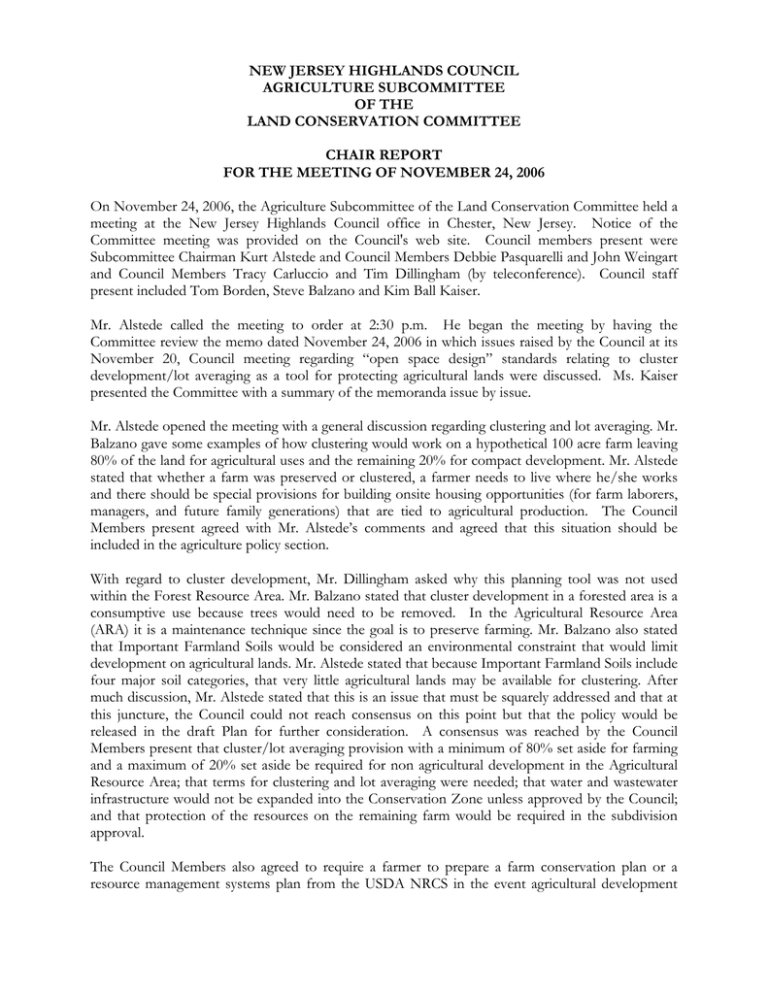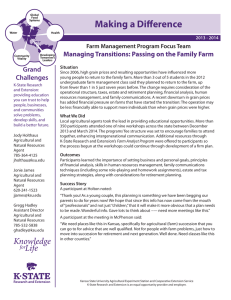NEW JERSEY HIGHLANDS COUNCIL AGRICULTURE SUBCOMMITTEE OF THE
advertisement

NEW JERSEY HIGHLANDS COUNCIL AGRICULTURE SUBCOMMITTEE OF THE LAND CONSERVATION COMMITTEE CHAIR REPORT FOR THE MEETING OF NOVEMBER 24, 2006 On November 24, 2006, the Agriculture Subcommittee of the Land Conservation Committee held a meeting at the New Jersey Highlands Council office in Chester, New Jersey. Notice of the Committee meeting was provided on the Council's web site. Council members present were Subcommittee Chairman Kurt Alstede and Council Members Debbie Pasquarelli and John Weingart and Council Members Tracy Carluccio and Tim Dillingham (by teleconference). Council staff present included Tom Borden, Steve Balzano and Kim Ball Kaiser. Mr. Alstede called the meeting to order at 2:30 p.m. He began the meeting by having the Committee review the memo dated November 24, 2006 in which issues raised by the Council at its November 20, Council meeting regarding “open space design” standards relating to cluster development/lot averaging as a tool for protecting agricultural lands were discussed. Ms. Kaiser presented the Committee with a summary of the memoranda issue by issue. Mr. Alstede opened the meeting with a general discussion regarding clustering and lot averaging. Mr. Balzano gave some examples of how clustering would work on a hypothetical 100 acre farm leaving 80% of the land for agricultural uses and the remaining 20% for compact development. Mr. Alstede stated that whether a farm was preserved or clustered, a farmer needs to live where he/she works and there should be special provisions for building onsite housing opportunities (for farm laborers, managers, and future family generations) that are tied to agricultural production. The Council Members present agreed with Mr. Alstede’s comments and agreed that this situation should be included in the agriculture policy section. With regard to cluster development, Mr. Dillingham asked why this planning tool was not used within the Forest Resource Area. Mr. Balzano stated that cluster development in a forested area is a consumptive use because trees would need to be removed. In the Agricultural Resource Area (ARA) it is a maintenance technique since the goal is to preserve farming. Mr. Balzano also stated that Important Farmland Soils would be considered an environmental constraint that would limit development on agricultural lands. Mr. Alstede stated that because Important Farmland Soils include four major soil categories, that very little agricultural lands may be available for clustering. After much discussion, Mr. Alstede stated that this is an issue that must be squarely addressed and that at this juncture, the Council could not reach consensus on this point but that the policy would be released in the draft Plan for further consideration. A consensus was reached by the Council Members present that cluster/lot averaging provision with a minimum of 80% set aside for farming and a maximum of 20% set aside be required for non agricultural development in the Agricultural Resource Area; that terms for clustering and lot averaging were needed; that water and wastewater infrastructure would not be expanded into the Conservation Zone unless approved by the Council; and that protection of the resources on the remaining farm would be required in the subdivision approval. The Council Members also agreed to require a farmer to prepare a farm conservation plan or a resource management systems plan from the USDA NRCS in the event agricultural development activities exceed 3% and 9% of impervious cover respectively and that these should be required in the Planning Area of the Highlands Region. The subcommittee also stressed the need to ensure that municipal conformance in the ARA would ensure Right-to-Farm ordinances and that obstacles to agricultural activities would be minimized. Lastly, the subcommittee stressed the need for long term policies, grants, and technical assistance to promote agricultural sustainability. The subcommittee requested that staff update the draft Regional Master Plan to be consistent with these recommendations. Ms. Carluccio and Mr. Dillingham left the meeting at 4:10 p.m. Mr. Alstede then opened the committee meeting for public comment. Helen Heinrich, New Jersey Farm Bureau recommended that the Council focus on educating the municipalities on how to be “farms friendly towns”. She mentioned that one of the problems with cluster is that the residential owners could “gang up” on the farmers regardless of a Right to Farm Act and make farming difficult. Ms Heinrich also discussed soils classifications, that Farmland Assessment Act only looked to Soil Classifications I and II, that the SADC used four categories for prioritizing farmland preservation and the Plan’s Agricultural Resources Area (ARA) used the same as SADC which results in much more constrained farmland in the Region. Ms. Heinrich recommended that exemptions and TDRs be clustered. Sylvia Kovacs, a planning board member, suggested that building requirements be modified so that farmers constructing a farm building were not subject to the same standards a Wal-Mart would be subject to. She also mentioned that the future of farming in the Region is a trend toward smaller farms. Jay Garrish, a Lebanon Township farmer, discussed his attempt to develop his farm. Mr. Garrish received municipal subdivision approval on his 118 acres farm sometime between the introduction of the Act and the Act’s enactment and was precluded from building the subdivision. Candy Ashmun, Pinelands Commission Member, stated that nothing had been had been said regarding TDR and that clustering would not let the farm be available for credits. She also mentioned that the Pinelands is using an alternate system to provide for labor housing on farms. Julia Somers, Highlands Coalition Executive Director, referred to Wilma Frey’s written comments regarding cluster development. She also reminded the Council that concentrated development could have adverse resource implication, especially with regard to karsts. Dave Peifer, ANJEC, recommended a utility analysis be done before cluster development took place; suggested that if soils classification for the ARA were trimmed that the other agencies also use the narrower classification; recommended that a farm management plan be required at the time of site plan application; concurred that a buffer on the residential cluster was a good idea and suggested that a nonprofit could be created to monitor easements.. Mr. Alstede then adjourned the Agriculture Subcommittee of the Land Conservation Committee meeting at 5:05 p.m. 2



